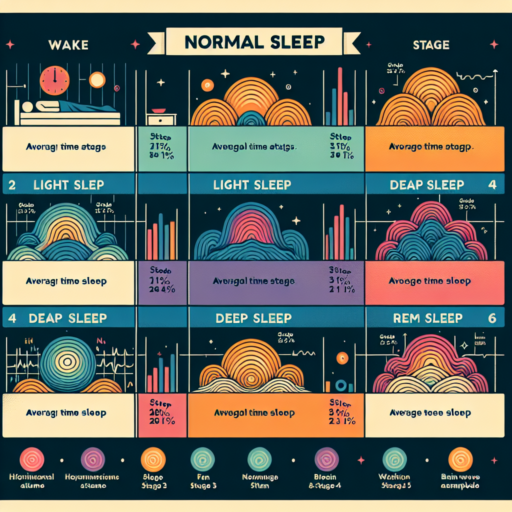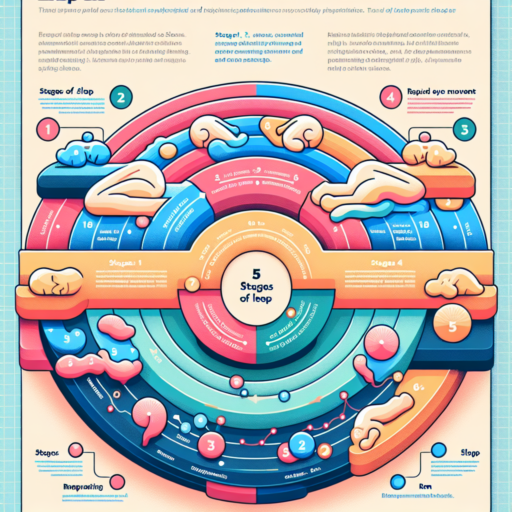Understanding Normal Sleep Stages: An Overview
Understanding the intricacies of the normal sleep stages is crucial for appreciating how our bodies rest and rejuvenate. There are primarily four stages of sleep, each characterized by different patterns of brain waves and physical activity. These stages play a vital role in our physical and mental well-being, impacting everything from memory consolidation to the repair of bodily tissues.
The Four Main Sleep Stages
- Non-REM Stage 1: This initial stage of sleep is a light, transitional phase where one drifts in and out of sleep. It’s marked by slow eye movements and decreased bodily activity. It’s during this stage that people often experience the sensation of falling, resulting in sudden, involuntary muscle contractions.
- Non-REM Stage 2: Slightly deeper than stage 1, this phase sees the cessation of eye movement, and the heart rate and breathing stabilize. Brain waves slow further, with occasional bursts of rapid waves known as sleep spindles. Most of the nightly sleep cycle is spent in this rejuvenating stage.
- Non-REM Stage 3: This is the deep sleep stage, crucial for physical recovery and growth. It’s characterized by very slow brain waves, mixed with smaller, faster waves. During this stage, the body repairs muscles and tissues, stimulates growth and development, and boosts immune function.
- REM Sleep: The final stage, known as Rapid Eye Movement sleep, is where most dreaming occurs. Brain waves become fast and irregular, resembling waking brain activity. REM sleep is essential for processing emotions and consolidating memories.
The cyclical progression through these sleep stages is important for achieving restorative sleep, highlighting the need to understand our body’s natural sleep rhythms. Each stage plays a unique role in ensuring that we wake up feeling refreshed and alert, ready to face the day’s challenges. Recognizing the significance of each can help individuals tailor their routines and environments to promote better sleep hygiene.
How to Interpret a Normal Sleep Stages Graph
Understanding how to interpret a normal sleep stages graph is pivotal for gaining insights into your sleeping patterns and identifying any potential problems. A normal sleep stages graph, often presented through sleep monitoring technology, divides your night’s rest into different stages, each representing a specific state of sleep.
Identify the Stages of Sleep
Initially, identifying the various stages on the graph is crucial. Typically, a sleep graph will show you periods of light sleep, deep sleep, REM (Rapid Eye Movement) sleep, and possibly wake times. Light sleep marks the transition between wakefulness and deeper sleep and may appear as shorter, shallower waves in the graph. Deep sleep shows as longer, slower waves, indicating the restorative phase of your sleep. REM sleep is characterized by quick, sharp waves, resembling those of being awake and is crucial for cognitive functions such as memory consolidation.
Analyzing Sleep Patterns
After identifying the stages, the next step is analyzing the pattern throughout the night. A healthy sleep cycle begins with a period of light sleep, progresses into deep sleep, then moves into a REM stage before the cycle resets. This cycle typically repeats every 90-120 minutes. On a normal sleep stages graph, you would expect to see 4-6 of these cycles throughout a standard 7 to 9-hour sleep duration. Significant deviations from this pattern may suggest sleep disturbances or disorders.
Note: The duration and quality of each sleep stage can vary significantly among individuals and can be influenced by factors such as age, lifestyle, and health conditions. Therefore, while interpreting your sleep graph, it’s important to consider personal circumstances that might affect your sleep architecture.
The Importance of Each Sleep Stage for Health and Wellbeing
Sleep is an indispensable component of our daily routine, influencing various aspects of health and wellbeing. Understanding the significance of each sleep stage is crucial for optimizing restorative sleep and enhancing life quality. The sleep cycle is divided into four stages, each playing a unique role in mental and physical health maintenance.
Role of Non-REM Sleep
The initial three stages of sleep are part of Non-Rapid Eye Movement (Non-REM) sleep. The first stage acts as a gateway between wakefulness and sleep, allowing the body to ease into a state of rest. During the second stage, our body starts to prepare for deep sleep by lowering temperature and relaxing muscles. The third stage, known as deep sleep, is fundamental for physical recovery, tissue repair, and immune system strengthening. Neglecting this phase can lead to decreased physical health and impaired cognitive functions.
Benefits of REM Sleep
Following Non-REM sleep, the Rapid Eye Movement (REM) stage occurs, characterized by increased brain activity, vivid dreams, and temporary body paralysis, which prevents acting out dreams. REM sleep is essential for cognitive functions such as memory consolidation, learning, and emotional regulation. This stage’s unique brain activity patterns support creativity and problem-solving abilities, highlighting its importance for mental health and overall wellbeing.
Comparing Normal Sleep Stages Across Different Age Groups
Understanding how sleep patterns change as we age is crucial for recognizing what is considered normal in each stage of life. Sleep is divided into several stages, each integral to our health and well-being. This comparison across different age brackets can shed light on why sleep disturbances may appear and how our sleeping needs evolve over time.
Infants and Sleep Stages
Infants spend a significant amount of their sleep in the Rapid Eye Movement (REM) stage, which is essential for the incredible development happening in their brains during these early years. This stage accounts for nearly half of an infant’s sleep, compared to only about 20-25% in healthy adults. Non-REM sleep, which is deeper and more restorative, occupies the other half of an infant’s sleep cycle, playing a crucial role in physical growth and development.
Adults and Sleep Stages
As we enter adulthood, the distribution between REM and non-REM sleep shifts. Adults typically experience longer periods of deep non-REM sleep, which is vital for immune function, tissue repair, and bone growth. However, the amount of deep sleep decreases with age, making older adults more prone to waking up during the night. This transition in sleep architecture can explain why adults often feel the effects of sleep disturbances more acutely as they age.
Elderly Sleep Patterns
For the elderly, the sleep stage composition shifts further, with an overall decrease in both REM and deep non-REM sleep stages. This age group is more likely to experience fragmented sleep and an increase in sleep latency, meaning it takes longer to fall asleep. Understanding these changes is critical for addressing sleep-related issues and ensuring that elderly individuals receive the restorative sleep they need to maintain their health and well-being.
Identifying Common Variations in Normal Sleep Patterns
Understanding diversities in sleep patterns is crucial for recognizing what is considered normal and when there might be reason for concern. Sleep, an essential aspect of overall well-being, varies significantly from person to person and even within the same person over different periods. Several factors contribute to these variations, including age, lifestyle, health conditions, and stress levels.
Age-Related Changes in Sleep
One of the most notable determinants of sleep pattern variations is age. Newborns and infants, for example, require approximately 14 to 17 hours of sleep daily, which gradually decrease as they grow. Adolescents, on the other hand, need about 8 to 10 hours. For adults, 7 to 9 hours are generally recommended. However, it’s not just the quantity of sleep that changes with age; the quality and structure, such as the proportions of different sleep stages, evolve as well.
Lifestyle Factors Influencing Sleep
Lifestyle choices also play a pivotal role in shaping sleep patterns. Factors such as exercise routines, dietary habits, and exposure to technology before bedtime can significantly impact the quality of sleep. Regular physical activity is known to promote better sleep quality, whereas consuming caffeine or large meals close to bedtime can disrupt it. Moreover, the blue light emitted from screens can interfere with the natural sleep-wake cycle, making it harder to fall asleep.
Understanding the nuances of normal sleep patterns aids in recognizing when changes could indicate underlying health issues. Keeping a regular sleep schedule and optimizing bedtime routines to support natural rhythms can help maintain healthy sleep patterns despite these common variations.
Normal Sleep Stages Graph: How to Read and What to Look For
Understanding the normal sleep stages graph is crucial for recognizing patterns in sleep quality and duration. This guide aims to break down the components of this graph, highlighting what each stage represents and the indicators of healthy versus disturbed sleep. When examining a sleep stages graph, it’s essential to familiarize yourself with the key phases of sleep: NREM (Non-Rapid Eye Movement) and REM (Rapid Eye Movement).
Interpreting the NREM Stages
NREM sleep is divided into three distinct stages: N1, N2, and N3, each marked by different brain wave activity and physiological responses. In the initial stages (N1 and N2), you’ll notice on the graph that the brain waves begin to slow down compared to the waking state, which is a sign of the body transitioning into a light sleep. The deepest sleep occurs during the N3 stage, characterized by even slower brain waves known as delta waves. This stage is crucial for physical recovery and growth. On a sleep graph, deep sleep is represented by longer, lower waves indicating lesser frequency but higher amplitude movements.
Recognizing REM Sleep on the Graph
Following the NREM stages, the sleep cycle culminates in the REM stage, easily identifiable on a graph by a unique pattern of brain activity that somewhat resembles waking brain waves, signifying active dreaming. Interestingly, despite the similarity in brain activity to the waking state, the body experiences muscle atonia (temporary paralysis), which prevents acting out dreams. On a graph, REM sleep is illustrated by shorter, more sporadic spikes indicating higher brain activity levels. This phase is pivotal for cognitive functions such as memory consolidation and mood regulation.
When analyzing a normal sleep stages graph, it’s beneficial to note the cyclical nature of sleep, with the body typically cycling through the NREM and REM stages 4-6 times during a good night’s sleep. The duration and quality of each stage can vary significantly among individuals and even from night to night. However, deviations from the typical patterns, such as significantly reduced REM sleep or excessive wakefulness periods, can be indicators of sleep disorders or other health issues. Recognizing these anomalies can be the first step toward seeking professional advice and improving sleep hygiene.
Tools and Apps for Monitoring Your Sleep Stages
In a world where technology meets health, tools and apps designed to monitor sleep stages have become invaluable for individuals seeking to enhance their sleep quality. These innovative solutions offer insights into an individual’s sleep cycle, shedding light on the depth and quality of rest attained through the night. By understanding the natural progression through different sleep stages, from light sleep to REM, individuals can tailor their sleep habits for a restful night.
The Rise of Wearable Sleep Trackers
Wearable technology has revolutionized the way we track our health, and sleep is no exception. Devices like Fitbit, Garmin, and Apple Watch have introduced features enabling users to meticulously monitor their sleep patterns. These gadgets analyze movements and heart rate to estimate the time spent in each sleep stage, offering insights that can prompt healthier sleep routines.
Specialized Sleep Monitoring Apps
Apart from wearable devices, the market is awash with specialized apps designed to monitor sleep stages without the need for additional hardware. Apps such as Sleep Cycle, Relax & Sleep Well, and Pillow utilize the smartphone’s microphone and accelerometer to track sleep. They analyze the user’s movements and sounds throughout the night, distinguishing between light sleep, deep sleep, and REM stages. These tools not only help users understand their sleep patterns but also provide recommendations to improve sleep quality.
Embracing these tools and apps for monitoring sleep stages represents a forward step in personal health technology. By leveraging the data collected, individuals can make informed decisions about their sleeping habits, leading to improved sleep health and overall well-being. The intersection of technology and sleep science continues to offer promising solutions for the pursuit of a good night’s sleep.
The Impact of Lifestyle Choices on Your Normal Sleep Stages
Understanding the impact of lifestyle choices on your normal sleep stages is crucial for maintaining a healthy sleep cycle. Lifestyle aspects such as diet, exercise, and stress levels play a significant role in how well we traverse through the various stages of sleep each night. These phases, including deep sleep and REM, are essential for cognitive function, mood regulation, and overall health.
One notable lifestyle factor is physical activity. Regular exercise promotes longer periods of deep sleep, the stage that is most restorative. However, timing is key; engaging in vigorous activities too close to bedtime can lead to difficulty falling asleep. In contrast, winding down with gentle exercises, such as yoga or stretching in the evening, can enhance sleep quality by preparing the body for rest.
An equally important factor is diet and caffeine consumption. Consuming heavy meals, caffeine, or alcohol close to bedtime can significantly disrupt your sleep cycle. These substances can delay the onset of sleep and alter the duration of each sleep stage, particularly reducing the amount of valuable REM sleep. Incorporating a balanced diet and limiting stimulants, especially in the hours leading up to sleep, can greatly improve sleep quality and ensure that the body properly cycles through all sleep stages.
No se han encontrado productos.
Expert Tips for Improving Your Sleep Quality and Optimizing Sleep Stages
Understand the Importance of a Consistent Sleep Schedule
One of the foundational principles for enhancing your sleep quality involves establishing and maintaining a consistent sleep schedule. Sleep experts concur that going to bed and waking up at the same time every day, even on weekends, significantly improves your sleep quality. This routine helps regulate your body’s internal clock, promoting easier sleep onset and more restful night’s sleep through the optimal navigation of sleep stages.
Create a Pre-Sleep Ritual to Wind Down
Developing a pre-sleep ritual is an essential step toward improving your sleep quality. This can include activities such as reading, taking a warm bath, or practicing relaxation techniques like meditation or deep-breathing exercises. The goal is to signal to your body that it’s time to shift gears and prepare for sleep. Dimming the lights and limiting exposure to screens and blue light from devices can also help in reinforcing your body’s natural rhythm, making it easier to fall asleep and progress through the sleep stages efficiently.
Optimize Your Sleep Environment
A conducive sleep environment is crucial for not just falling asleep but also for moving smoothly through the different sleep stages. Ensure your sleeping area is quiet, dark, and at a comfortable temperature. Investing in a good quality mattress and pillows that support your body’s natural alignment can make a significant difference. Additionally, consider using blackout curtains or a white noise machine to block out disturbances that can prevent you from entering the deeper, more restorative stages of sleep.
The Future of Sleep Research: What’s Next for Normal Sleep Stages?
The exploration of sleep has always been a fascinating journey, uncovering the layers of mystery that shroud our nightly slumber. As we delve deeper into the future of sleep research, the focus sharpens on the revelation and understanding of normal sleep stages. This domain is ripe for technological advancements, methodological innovations, and interdisciplinary studies that promise to redefine our grasp on what constitutes a healthy sleep pattern.
Technological Innovations in Monitoring Sleep Stages: With the advent of cutting-edge technologies, researchers are now armed with more detailed and accurate tools to study sleep. Wearable devices and sophisticated sleep tracking algorithms are on the verge of offering granular insights into the transitions and nuances of sleep stages. These developments not only aim to enhance the precision of sleep stage classification but also open new vistas for personalized sleep interventions.
Genomic Insights and Personalized Sleep Medicine: The realm of genomics holds the key to untangling the genetic threads that influence our sleep architecture. As research deepens, there’s an anticipation of a shift towards personalized sleep medicine, where individual genetic markers dictate tailored sleep hygiene strategies and interventions. This approach could revolutionize how we approach sleep disorders and the optimization of normal sleep stages for overall health and well-being.
Interdisciplinary Approaches to Understanding Sleep: The future of sleep research is inherently interdisciplinary, combining insights from psychology, neurology, anthropology, and even artificial intelligence, to paint a comprehensive picture of sleep stages. By bridging these diverse fields, scientists aim to unlock a more holistic understanding of sleep mechanisms, challenges, and innovations. This synergistic approach may reveal yet undiscovered aspects of normal sleep stages, propelling the field into new territories of exploration.




